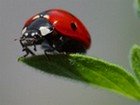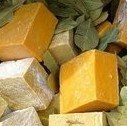Understanding Gentically Modified Foods and How to Avoid them
by Justin Doody
(Denver, Colorado, USA)

We hear a lot of talk of Genetically Modified Organisms (GMOs) these days, what foods contain them and are they really so bad for us?
First let's understand a little about GMOs. There's a bacteria that lives in soil known as Bacillus thuringiensis that produces a toxic substance that kills pests on food crops (corn and soybeans, for example). You could say that it contains an organic and natural pesticide.
Somehow, scientist familiar with genetic engineering realized that they could take the toxin-producing gene from the bacteria and introduce it into crops. After a few tries, a crop strain that produces the natural pesticide was found and proven to be more resistant to attacks from ravenous insects.
You might ask "Is it such a bad thing to have insect resistant plants for food consumption?" It seems like a good idea at first until we start seeing consequences in our health.
Unfortunately, the toxic substance that's produced by the soybeans could accumulate in our bodies, and it is difficult to say what are its long-term impacts. What is even more distressing is that the genetic material that causes the soy to produce natural pesticide can be transferred to the genetic structure of native bacteria that inhabit your intestines, and they may continue making toxin for decades. And the possible problems don’t stop right here.
In many cases, GM food products have been shown to threaten us with health problems, including:
Fragments of genetic material from GM crops have been found throughout the body and even brain of cattle that have been fed GM foods.
Foreign proteins found in GM food products can cause mild to severe allergic reactions. In some countries, the incidence of soy allergies jump to about 50 percent after GM soy was made available.
A couple of years ago, a supplement that uses GM materials were released to the public without proper tests. Before it was withdrawn off the market, it might be linked to nearly 40 deaths and thousands of other reported health problem cases.
You should think hard about how GM foods can affect your family, and find a way to limit the amount consumed and if possible eliminate GM foods that could already be present in your everyday eating habits.
GM foods often look similar with unmodified foods, so it can be tricky to tell whether a food product contains GM ingredient, especially if you are shopping for food products in countries with advanced agriculture technology, such as United States. There is an exception, though, for example the European Union, all GM food products must be properly labeled to let buyers know that they contain GM ingredients.
When you are trying to determine which foods contain GM ingredients, it is a good idea to know which animals and plants are usually modified.The most common GM foods are soybeans and corn – two of the most important calories sources in many countries.
Recent estimates show that roughly three-quarters of soybean crops and about a quarter the corn crops have been genetically modified in the U.S.
That’s a vast amount of food! Both crops are used to produce many different kinds of food ingredients that are used in processed foods (for example, high fructose corn syrup and soybean oil are found on many processed foods in the grocery store). Some scientists say that when we add up all the GM foods that are made with GM ingredients, nearly 80 percent of foods that are sold in grocery store in the U.S. contain genetically modified ingredients in some sort of way.
Several other crops are regularly messed with at their genetic level, including wheat, rice, alfalfa, squash, papaya, tomatoes, canola, sugar cane, sugar beets, cantaloupe, flax and potatoes.
This is not a complete list by any means, as it's next to impossible to obtain accurate information about which crops that have been modified genetically.
The reviews and regulations of genetic modification on food products are lax and sparse at best. And it isn't limited to plants. Major bio-tech companies are now making GM animals, too.
Until now, cows, goats, fish, and pigs have been genetically modified to enhance some of their benefits for human and for now it seems that trend isn't slowing down. Just like with GM plants, too few rules or regulations exist to curtail the use of GM animal-derived ingredients for food in the U.S., so it can be really tough to know what has been genetically modified and what hasn’t.
So what you should do when entering a grocery store and find shelves of foods that are likely have been altered genetically?
In some countries, there are no requirements for GM foods. The real way to ensure you are not buying or consuming GM foods is to find a "100 percent organic." label. That's actually a viable practice to follow whenever you have the opportunity.
Many animals are fed GMO derived feed. According to Weston A. Price Foundation, meat, dairy, farmed fish and eggs are given GMO fed from corn, soy and wheat to raise these animals for market for consumers to buy.
In order to avoid GMO-fed meats, dairy products, fish and eggs; look for organically fed animals or 100% grass-fed. Look for organic dairy products that are derived from cows that are not injected with bovine hormones to increase milk production.
GMO crops increase the possibility of introducing new allergens to humans with the cross-pollination of new genes from other plants, animals and microorganisms. Introducing new genes to plants from animal, human or other plant sources that normal wouldn't cross-pollinate under natural circumstances may pose a risk to humans.
Corn is used primarily as a concentrated sweetener for baked goods and carbonated soft drinks. High fructose corn syrup is widely used in consumer goods. Cooking oil made from corn oil is derived from genetically engineered corn. Bees and monarch butterflies populations have decreased with the growth of GMO corn.
The GMO foods pose an environmental threat by destroying bee and butterfly populations, according to Mellon and Rissler.
Bees and butterflies naturally pollinate flowers of crops that ensures the natural growing cycle of plants. By disrupting this cycle with the introduction of corn crops that are coded with a pesticide introduces plants that naturally are not supposed to survive.
The coded pesticide inside the GMO crops kill insects that are not resistant to the pesticide. Scientists do not fully understand the environmental effects of losing bees and butterflies.But now they are seeing the impact on butterflies and bees, scientist have discovered that populations are declining and mutations are being found in their DNA.
Huffington Post reports on studies done by the Russian Academy of Sciences, and completed in 2010. Researchers fed hamsters GMO soybeans over a two-year period. The GMO soybean-fed hamsters had poor weight gain and a high infant mortality rate. By the third generation, most of the GMO-fed hamsters were sterile.
An earlier study in 2005 at the Russian Academy of Sciences used mother rats and their offspring. More than half of all baby rats whose mothers were fed GMO soybeans died within three weeks. Surviving baby rats suffered from low weight, poor growth and sterility.
One of the modifications made to GMO corn is the insertion of genes from the bacteria Bacillus thuringiensis, or Bt.
According to the Mothers for Natural Law website, the Bt genes are used to control larval stages of insects that damage corn. The toxin in natural Bt is an effective organic insecticide when dusted on a crop in the traditional manner, and it degrades naturally.
The molecular structure of the Bt toxin in GMO corn, however, is unnaturally truncated. The Bt toxin is released from the roots of the GMO corn into the soil, where it remains bound to soil particles and does not degrade. One bacterium developed for GMO seed corn specifically designed for ethanol processing left residues that made the soil infertile. Subsequent corn crops grew three inches tall and died.
So as we can see the benefits of GMO crops are outweighed by all the long term consequences. GMO’s cause severe health risk and screwing up the natural order of things for profit. There is nothing good or healthy about GMO foods, and to be told different is just being lied to by big Pharma, FDA, Monsanto, and USDA.
So how do we avoid all these foods if it seems most of our food chain has been introduced to GMO’s? Here some things to look for:On labels of products look for PLU code and look for these numbers:
If it's a four digit number, the food is conventionally produced. If it is a five digit number beginning with an 8 it is genetically modified (GM). If it is a five digit number beginning with a 9 it is organic.
Make sure your eggs say (natural or cage free-free range) and 100% organic. Purchase beef that is grass fed and 100% organic with no injected bovine growth hormone.
Although alfalfa and other grain can be GMO in their own right before being fed to animals, you will have to find a company that does not use these crops.
Shopping at your local farmers market and butcher can increase your safety in your food. Remember that anything that comes in a box is usually fake food filled with GM ingredients. So make meals from scratch and know where your ingredients come from. Labels can be misleading so read thoroughly.
To ensure the purest quality food in your families food supply is to grow your own food. It may seem like a lot of work, but modern farmers and urban farmers are popping up everywhere.
Using new gardening techniques, you can produce 25% of your food supply and 100% of your fruits and veggies supply.
Having peace of mind when eating is really a big deal. There are people and companies out there who will lie to you for your money.
Keep your money and grow your own food supply or as much as you can. The benefits of your health and peace of mind is priceless.
Comments for Understanding Gentically Modified Foods and How to Avoid them
|
||
|
||
|
||
|
||
Did you find this page helpful?
Sharing is a way of saying, "Thanks!"
Follow Us and Keep Up to Date
Go back to the Home Page





